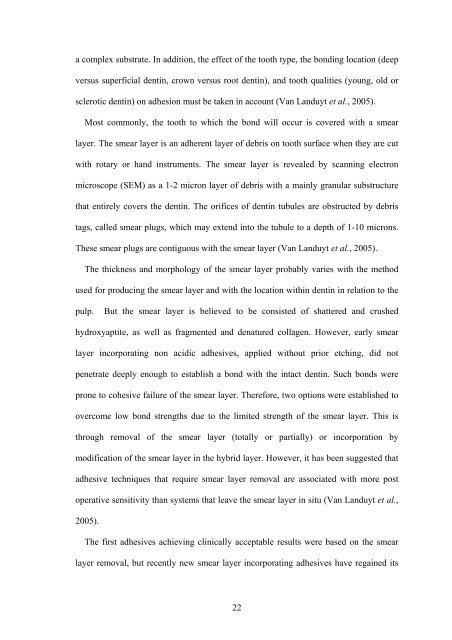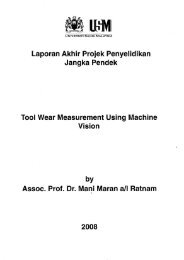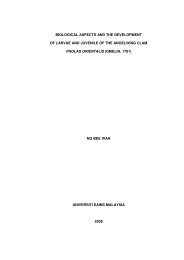microleakage in class ii composite restorations ... - ePrints@USM
microleakage in class ii composite restorations ... - ePrints@USM
microleakage in class ii composite restorations ... - ePrints@USM
Create successful ePaper yourself
Turn your PDF publications into a flip-book with our unique Google optimized e-Paper software.
a complex substrate. In addition, the effect of the tooth type, the bond<strong>in</strong>g location (deepversus superficial dent<strong>in</strong>, crown versus root dent<strong>in</strong>), and tooth qualities (young, old orsclerotic dent<strong>in</strong>) on adhesion must be taken <strong>in</strong> account (Van Landuyt et al., 2005).Most commonly, the tooth to which the bond will occur is covered with a smearlayer. The smear layer is an adherent layer of debris on tooth surface when they are cutwith rotary or hand <strong>in</strong>struments. The smear layer is revealed by scann<strong>in</strong>g electronmicroscope (SEM) as a 1-2 micron layer of debris with a ma<strong>in</strong>ly granular substructurethat entirely covers the dent<strong>in</strong>. The orifices of dent<strong>in</strong> tubules are obstructed by debristags, called smear plugs, which may extend <strong>in</strong>to the tubule to a depth of 1-10 microns.These smear plugs are contiguous with the smear layer (Van Landuyt et al., 2005).The thickness and morphology of the smear layer probably varies with the methodused for produc<strong>in</strong>g the smear layer and with the location with<strong>in</strong> dent<strong>in</strong> <strong>in</strong> relation to thepulp. But the smear layer is believed to be consisted of shattered and crushedhydroxyaptite, as well as fragmented and denatured collagen. However, early smearlayer <strong>in</strong>corporat<strong>in</strong>g non acidic adhesives, applied without prior etch<strong>in</strong>g, did notpenetrate deeply enough to establish a bond with the <strong>in</strong>tact dent<strong>in</strong>. Such bonds wereprone to cohesive failure of the smear layer. Therefore, two options were established toovercome low bond strengths due to the limited strength of the smear layer. This isthrough removal of the smear layer (totally or partially) or <strong>in</strong>corporation bymodification of the smear layer <strong>in</strong> the hybrid layer. However, it has been suggested thatadhesive techniques that require smear layer removal are associated with more postoperative sensitivity than systems that leave the smear layer <strong>in</strong> situ (Van Landuyt et al.,2005).The first adhesives achiev<strong>in</strong>g cl<strong>in</strong>ically acceptable results were based on the smearlayer removal, but recently new smear layer <strong>in</strong>corporat<strong>in</strong>g adhesives have rega<strong>in</strong>ed its22
















